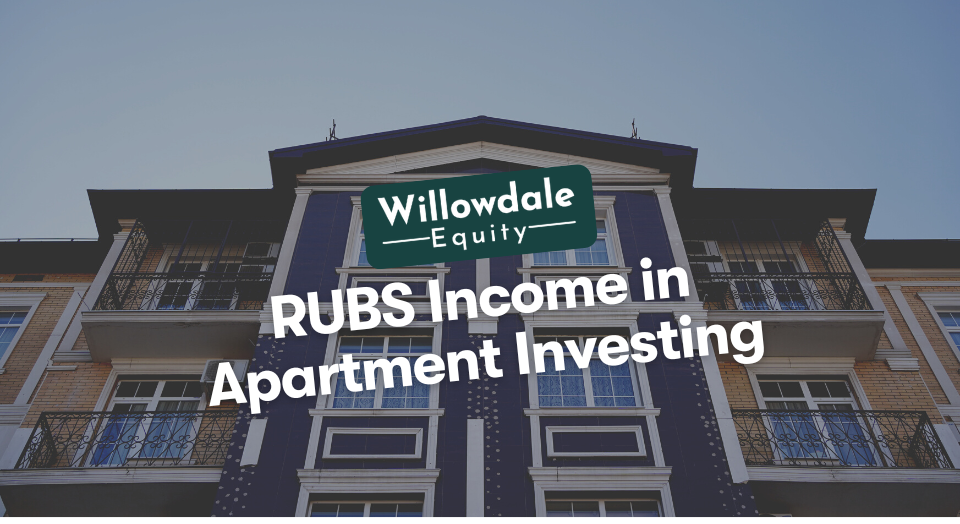
What is RUBS Income and What Does RUBS Mean for Apartments?
This article is part of our guide on passive investing in multifamily via syndication, available here.
As a multifamily investor, you realize how expensive utilities can be. If you’re not careful, utility bills can consume a significant portion of cash flow, directly affecting the value of your assets. Some landlords try to minimize this possibility by charging extra for monthly utilities.
Other property owners may opt for installing an individual meter for each unit. However, when it comes to multifamily properties, submetering every unit can be quite expensive and time-consuming, especially if the building wasn’t built to separate each unit’s utilities. So, what’s the solution for such a scenario?
Enter Ratio Utility Billing System (RUBS). Today’s blog post will examine RUBS income, benefits, and potential downsides.
Key Takeaways
-
RUBS refers to a monthly utility bill calculation system that accounts for factors such as the unit’s square footage, number of bathrooms, and number of people residing in the unit.
-
The main goal of RUBS income is to distribute the utility bill cost amongst the tenants from a neutral standpoint. Every utility, such as water, electricity, and gas, has its own distinctive formula to ensure that the utility bill is fairly distributed among the tenants.
-
Some multifamily property landlords choose the flat fee approach instead of implementing RUBS. This is where the tenants pay a certain amount on top of their monthly rental payments for utilities.
What is RUBS Income?
RUBS refers to a monthly utility bill calculation system that accounts for factors such as the unit’s square footage, number of bathrooms, and number of people residing in the unit. The system also considers other factors related to utility usage, such as how many gas appliances the unit has, how many water fixtures each unit has, and many others.
RUBS income is a great way for landlords to offset their costs and get the tenant base to reimburse them without going through the costly hassle of individually metering the units. Tenants have to agree to the system before it’s implemented. Besides, landlords must check with their local authorities since it isn’t legal in all cities.
So, how do landlords arrive at the amount each tenant should pay?
What Determines What Each Tenant Pays?

The main goal of RUBS income is to distribute the utility bill cost amongst the tenants from a neutral standpoint. Every utility, such as water, electricity, and gas, has its own distinctive formula to ensure that the utility bill is fairly distributed among the tenants.
Here are some questions every landlord has to ask themselves before implementing the RUBS income formula:
- What’s the square footage for every unit?
- How many water fixtures does each unit have?
- What’s the number of bedrooms and bathrooms in every unit?
- How many occupants does each unit have?
- Are there any appliances, such as HVAC, gas stove or dryer in the units?
The landlord or property manager can distribute the utility bill in various ways. For example, they can assign each factor a percentage that will divide the utility bill based on how much each tenant has used them.
Alternatively, they can also simply divide the bill among the number of units. If the monthly water bill is $350 and there are 7 units, the landlord can charge every tenant $50 for water use.
The property owner can also use the same formula but use square footage. Assuming the entire property has 10,000 square feet of rentable living area and the monthly electricity bill is $1,500, each tenant can pay $0.15 per square foot.
The landlord has to include the RUBS income clause in the lease agreement, including the formula they use to calculate RUBS. Each tenant is responsible for paying every month’s share; otherwise, they risk breaching the contract terms.
What Does RUBS Mean for Apartments?
RUBS refers to a fair distribution of utility bills in a balanced way for apartments without submeters. Submeters measure the utility bill for each unit individually in a particular period. Installation of submeters depends on the plumbing and electrical system configuration.
It’s easy to install submeters when constructing a new apartment since you just include them in the plan. However, it’s costly to install in an existing apartment and can become impossible depending on the construction of the apartment.
With RUBS, you can divide the utility bill among your tenants fairly.
Good Read: What is a Rent Premium in Apartments?
The Advantages of Using RUBS
Here are some benefits of RUBS income that landlords enjoy:
- Saves you money: If you implement the RUBS formula correctly, you pay for the utility bills 100% and avoid paying for the costs from your own pocket. It also saves you the money you would have spent installing an individual meter for every unit. Besides, it doesn’t require an initial investment amount to set up.
- Tenants become more conservative: When tenants pay a flat fee for their utilities, they tend to abuse them. They may leave the lights or HVAC system on the entire day even when they don’t necessarily need them. This may cause the landlord to increase rent if they’re yet to implement the RUBS system. With RUBS, however, they know that they’re billed for utility usage, preventing them from misusing the utilities.
- Boosts property value: RUBS helps decrease the utility bills and hence increases the net operating income (NOI). This ultimately boosts the property’s market value which is extremely helpful if you choose to sell or refinance your property.
The Disadvantages of Using RUBS
While the benefits of RUBS are quite pronounced, there are a few possible downsides that every landlord needs to be aware of. They include:
- Some tenants may not comply: Sometimes. RUBS may lead to extended vacancies since some tenants aren’t willing to contribute to the utility bills. Existing tenants may also decline the implementation of RUBS. You don’t want to find yourself in a situation where some units utilize RUBS and others don’t.
- Legal issues: RUBS may not be permitted in some housing markets. Others may view the system as unfair, especially if you charge a flat fee or use the square footage formula without accounting for other factors. It’s important to check with the local government before implementing this system.
- Careless tenants: If one tenant abuses the utilities, it may unfairly raise the costs for everyone else. A tenant could also breach the contract and refuse to pay the bill. In this case, the landlord is left with no other option but to evict the tenant or raise the payments for everyone else to compensate for the careless tenant.
Using a Flat Fee Approach Instead of RUBS
Some multifamily property landlords choose the flat fee approach instead of implementing RUBS. This is where the tenants pay a certain amount on top of their monthly rental payments for utilities. The flat fee is calculated depending on the size of the unit. The more the square footage, the higher the flat fee.
However, there are some major downsides to this strategy. Firstly, utility costs vary depending on the neighborhood. The tenant may feel short-changed if they find out they’ve been paying higher than the locality rate. This strategy also makes it hard for tenants to know their utility usage.
In addition, tenants who pay a flat fee may become careless regarding utility usage. This may lead to major issues since you must raise the rent to cover the high utility bills.
Frequently Asked Questions About RUBS Real Estate
RUBS helps landlords distribute the utility bill to each tenant fairly and impartially. The RUBS system accounts for factors such as square footage, water fixtures, number of bedrooms and bathrooms, number of occupants, and number of appliances in each unit.
The RUB formula depends on the percentage the landlord assigns each utility to ensure the bill is distributed fairly. The formula includes utilities such as electricity, water, and gas.
What is RUBS Income - Conclusion
The RUBS formula is a great solution for landlords who want to avoid raising the rent due to utility bills. If implemented correctly, it helps you save money since you don’t have to install submeters. Ultimately, it increases your property’s market value. Be sure to check with the local authorities to avoid any legal issues in the future.
Join the investor club today to get access to private value-add multifamily real estate investment opportunities.
Sources:
- Multi Family Utility, “What Is a RUBS Program?”
- Synergy Utility Billing, “RUBS Billing Method: Is It Right For You?”
Interested In Learning More About PASSIVE Real Estate Investing In Multifamily Properties?
Get Access to the FREE 5 Day PASSIVE Real Estate Investing Crash Course.
In this video crash course, you’ll learn everything you need to know from A to Z
about passive investing in multifamily real estate.
We’ll cover topics like earned income vs passive income, the tax advantages, why multifamily, inflation, how syndications work, and much much more!




